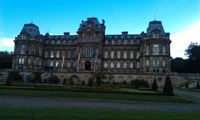Published: 11 Sep 2013
Yesterday I had the pleasure of visiting the wonderful Bowes Museum to listen to the last lecture in the series celebrating the life and times of local boy Jeremiah Dixon. Most surveyors at least will be aware of the famous Mason Dixon Line as it such an important part of our history.
The lecture was given by Edwin Danson, a name familiar to many members of TSA and Chartered ICES. Ed’s lecture was based on his book, “Drawing the line” although never at one point did he try to push or sell the book. An opportunity missed there by Ed. The lecture was part of a programme of events at the Bowes Museum celebrating the 250th anniversary of the start of the survey of the line in 1763. Much laughter was heard when one of the slides had a typo showing 1963 instead of the actual year. Ed covered that up like a true pro. The Bowes Museum has also been holding an exhibition dedicated to the life of Jeremiah Dixon who was born just a few miles away.
The exhibition closes in early October so if you want to see it you had better get a move on. It really is worth the visit and thanks go to the irrepressible pair of Jonathan and Caroline Peacock for making all of this possible.
I do not intend to write much about the lecture preferring to direct you towards the book or the Wikipedia link below. However a few facts are worth recording on this monumental task. The line was commissioned as a result of an 82 year long boundary dispute. Now that would be music to surveyor’s ears in modern times. The MD Line measured some 233 miles in length (some articles refer to it as being in excess of 300 miles long) and took just over five years to measure with a crew at one stage of about 120 including porters, cooks, security guards, etc. No one man operation total stations here then! They did encounter problems when they travelled through Indian country, a bit like London in modern times, and so had to employ a number of Indian guides and translators. Ed was told by his publishers that he could not use the term Indians and would have to use “native Americans” instead. He ignored this and used the term that all Roy Rogers’ fans will understand. Charles Mason was an astronomer from Gloucester and Jeremiah was a surveyor, cartographer from County Durham, an ideal combination according to Ed. In fact Mason liked America so much that he returned some 13 years after the completion of the Line to live in Philadelphia but only survived one month before his death. The two intrepid “surveyors” were also famous for being the first Englishmen to accurately measure the circumference of the World. An amazing achievement in those early days of survey measurement! Jeremiah died in 1779 at the young age of 45 but what a life he had led and what memories he has left us with.
http://en.wikipedia.org/wiki/Mason%E2%80%93Dixon_line
Jeremiah Dixon, a Quaker, never married but in attendance at the lecture were a number of his direct descendants. I did feel at one time that I had gate-crashed a private party although some of the descendants had never met each other either. It is rumoured that Jeremiah did produce a number of offspring with a local lady but this is not official although she is mentioned in his will as are two of her daughters. A bit of Northern scandal here! I spent most of the afternoon with one of Jeremiah’s direct descendants, 80 year old George Dixon a retired headmaster who still lectures on Jeremiah’s life and times. George is an amazing man and in addition to his in depth knowledge of Jeremiah, we also spoke about football. No surprise there! I mentioned that I remember Bob Hardisty from Bishop Auckland. In the 1950’s Bob was the top amateur player in England and captained his country at two Olympic Games. In amateur circles he was as famous as Wayne Rooney is now. Imagine my surprise when George told me that he had played with him.
So a fantastic day all round, listening to two passionate men talking about a subject dear to their hearts. I feel quite honoured to have been there.


